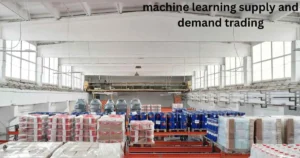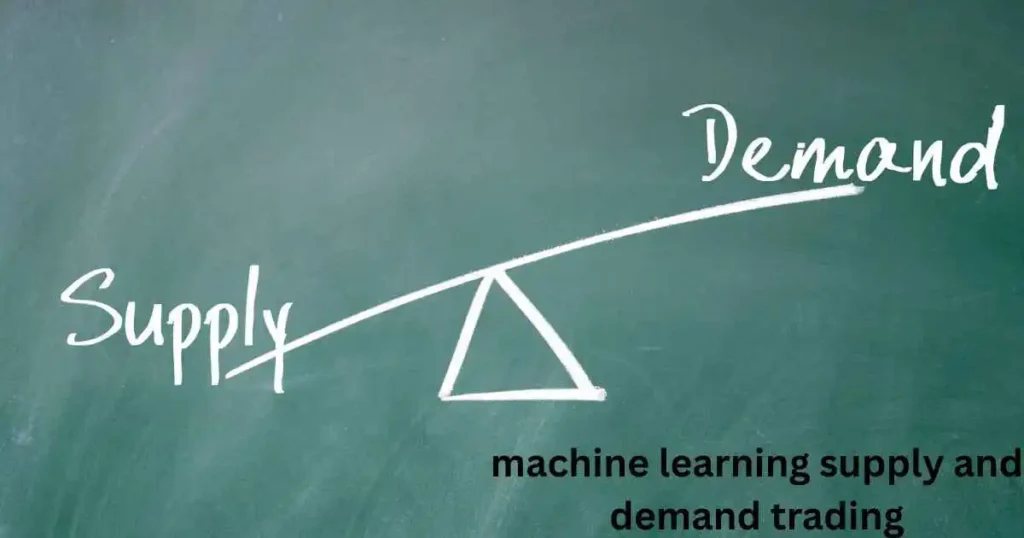Have you ever wished you could predict when to purchase or sell stocks? What if I told you that machines can do that for you? Greetings from the Machine Learning Supply and Demand Trading. Don’t worry if this sounds complicated or technical. You will know exactly what it is, how it operates, and how it can make you a better trader by the end of this essay.
In trading, what are supply and demand?
Let’s begin with the fundamentals. The price in trade is determined by supply and demand. Consider it this way: A stock’s price increases if there is a high demand for it (many people want to purchase it) and a low supply (few people are selling it). On the other hand, the price decreases if there is a great supply of goods and a low demand for them.
It’s similar to visiting a fruit market. The price of mangoes increases if they are in high demand. Prices drop if there are too many mangoes on the market and not enough customers. Trading is no exception.
Let’s move on to machine learning.
What role does machine learning play, then?
Computers can learn from data and generate predictions using machine learning. We give the machine a large amount of data, and it looks for patterns rather than implementing rules one line at a time.
These trends in trade could be:
When large investors make silent purchases (a process known as accumulation)
When a price reversal is likely
The impact of news on supply and demand
Machine learning can assist in forecasting when a favorable trading opportunity will present itself by recognizing these trends.
Anecdotally, I discovered the hard way
I attempted trading a few years ago using advice from a WhatsApp group. I lost most of the time, but occasionally I won. It was like speculating. Then, I learned about trading with AI and machine learning. I didn’t believe it. However, after testing out some basic tools and viewing a few movies, I concluded that it was arithmetic, not magic. and information. And far more trustworthy than sporadic hints.
How Are Supply and Demand Zones Determined by Machine Learning?
Here’s a detailed breakdown of what goes on behind the scenes:
Gather information on past prices, volume, news stories, and technical indicators.
Clean Data: Prepare it for training by eliminating errors and normalizing values.
Selecting Features: Pick the most crucial inputs, such as changes in price or spikes in volume.
Model Training: To learn from the data, apply algorithms such as LSTM, XGBoost, or Random Forest.
The model forecasts the areas where supply or demand is most likely to start.
Backtesting: Evaluate the model’s performance using historical data.
Finding locations where the price is expected to shift direction and trading accordingly is the straightforward objective.
Why It Is More Effective Than Humans Occasionally
People have feelings. We become impatient, fearful, or greedy. No, machines don’t. They conduct unbiased pattern analysis.
For instance, based on past recoveries, a machine learning algorithm may identify a market drop as a fantastic purchasing opportunity when most traders are panicking.
Additionally, machines are capable of processing far more data than humans, including thousands of technical indicators, news items, and stock charts, in a matter of seconds.
Well-liked ML Trading Tools and Platforms
Here are some easy-to-use resources for those who are eager to experiment with machine learning supply and demand trading:
TradingView: Excellent for scripting tactics and graphing.
Python and MetaTrader: Linking coding and trading.
You may backtest ML-based methods with QuantConnect.
Kaggle: Provides practice datasets and machine learning contests.
TensorFlow and scikit-learn are libraries for creating and refining machine learning models.
Semantic Terms to Be Aware of
Here are some key terms associated with machine learning supply and demand trading to aid in your comprehension (and SEO):
Trading with algorithms
Financial markets using AI
Forecasting price action
forecasting models for trading
techniques for quantitative trading
Automated zones of supply and demand
Science of financial data
Examination of market sentiment
In detail: Launch Your Initial ML Trading Plan
Let’s do something about it:
Choose a market based on your interests, such as stocks, forex, or cryptocurrency.
To obtain data, use free resources such as Quandl, Alpha Vantage, or Yahoo Finance.
Select a Tool: Python is popular and easy for beginners to learn.
Prepare the data: Make it more readable for the algorithm.
Develop the Model: Try regression (price forecasting) or classification (buy/sell signals).
To prevent overfitting, test and validate using unseen data.
Go Live With Caution: Begin with a small amount of money or a demo account.
Is There No Risk?
Not at all. Risk is a part of any trading. Despite its strength, machine learning is not flawless. Unexpected events, world news, and human emotion all have an impact on the markets. However, you have a far higher chance of making well-informed, data-driven decisions when you use machine learning supply and demand trading.
Are You Prepared to Jump Right In?
Using machine learning supply and demand trading could be your next major move if you’re sick of speculating and want to trade more intelligently. A data scientist is not required. All you need are the appropriate resources, curiosity, and a readiness to study.
Why not begin now? Examine the available resources, attempt a basic model, and see how machine learning may transform your trading strategy. How much a machine can tell you about human behavior in the marketplace may surprise you.
To make your trading strategies even stronger, consider learning from courses like CSU Machine Learning Severe, where you can dive deeper into how machines can predict market movements, just like how they analyze supply and demand in trading.


